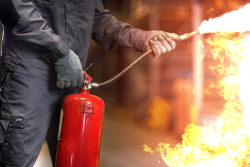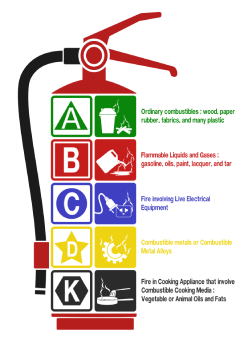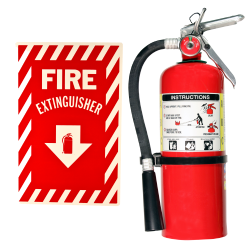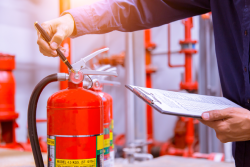Fire Extinguishers
Having a fire extinguisher within reach can help you create a path to safety and may even help put out a small contained fire. OSHA has several requirements pertaining to fire extinguishers that address placement, access, and employee training.
To understand the use of fire extinguishers, it is important to understand the assigned ratings. These ratings correspond to the type of fire they are designed to extinguish.
Types of Fires
 Fires are classified based on the type of material fueling the fire.
Fires are classified based on the type of material fueling the fire.
- Class A fires: wood, paper, cloth, rubber, and many types of plastics.
- Class B fires: flammable liquids and gases including gasoline, solvents, propane, and paints.
- Class C fires: anything plugged into electricity.
- Class D fires: metals, including combustible powders, shavings, or flakes of metals such as magnesium, titanium, potassium, and sodium.
- Class K fires: cooking oils and fats.
Types of Fire Extinguishers
 Fire extinguishers are categorized based on what type material they extinguish. The proper extinguisher must be used on the appropriate type of fire
Fire extinguishers are categorized based on what type material they extinguish. The proper extinguisher must be used on the appropriate type of fire
- Water and Foam Fire Extinguishers: Only for use on Class A fires.
- Carbon Dioxide Fire Extinguishers: Only for use on Class B and C fires.
- Dry Chemical Fire Extinguishers: For use on Class B and C fires.
- Wet Chemical Fire Extinguishers: Used for Class K fires. Some can be used on Class A, but not all.
- Clean Agent Fire Extinguishers: For Class B and C fires.
- Dry Powder Fire Extinguishers: Only for Class D fires.
- Cartridge-Operated Dry Chemical Fire Extinguishers: Can be used for Class B, and C fires.
- Water Mist Fire Extinguishers: Can be use on Class A and C fires.
Placement of Extinguishers
Portable fire extinguishers must be placed so that the travel distance for employees does not exceed the requirements and they are always accessible. They must also be placed at or near exits and near other known hazard areas. They are required to be stored at a height and location in the workplace that is easily accessible. OSHA’s specific guidance says fire extinguishers “should be mounted on brackets or in wall cabinets with the carrying handle placed 3-1/2 to 5 feet above the floor.” A fire extinguisher of 40lbs or heavier shall be placed no more than 3.5 feet off the ground; fire extinguishers of less than 40lbs shall be placed no more than 5 feet off the ground.
While there are no specific signage requirements, the regulations do require fire extinguishers to be “identified” and the best approach  to meeting this requirement is to provide a sign or sticker, to identify them.
Signs need to be visible and legible from a distance without obstructions of view or access. Furthermore, according to the Americans with Disabilities Act, any object mounted on a wall may not protrude off the wall more than 4 inches. Therefore, many
fire extinguishers are kept in recessed cases on the wall or in cabinets.
to meeting this requirement is to provide a sign or sticker, to identify them.
Signs need to be visible and legible from a distance without obstructions of view or access. Furthermore, according to the Americans with Disabilities Act, any object mounted on a wall may not protrude off the wall more than 4 inches. Therefore, many
fire extinguishers are kept in recessed cases on the wall or in cabinets.
The distance the employee must travel from the place of potential fire to the fire extinguisher is also regulated. Distance requirements vary by the type of extinguisher.
- Extinguishers that put out Class A and D fires must be placed so that the travel distance for employees to any extinguisher is 75 feet or less.
- Extinguishers used for Class B fires must be placed at 50 feet away or less.
- Portable fire extinguishers used for Class C hazards are to be placed on the basis of the appropriate pattern for the existing Class A or Class B hazards.
- Finally, extinguishers used for Class K hazards must be placed at a maximum travel distance of 30 feet.
You can find more guidance on fire extinguisher placement on OSHA’s eTool.
Training Options
Employers have a few options when it comes to who can use the fire extinguishers. No matter the option chose, all require the establishment of an Emergency Action Plan and a Fire Prevention Plan that includes employee training. PRINTING United Alliance Emergency Action Plan Template includes both elements.
Options for appointing personnel to operate fire extinguishers in the case of an emergency are as follows:
- Total Evacuation a. All building occupants evacuate at the sound of the fire alarm; no training is required.
- Only Designated Employees Can Use Portable Fire Extinguishers a. This option allows only certain, designated employees to fight fires. All employees that are designated to use fire extinguishers must receive annual fire extinguisher safety training. All other employees must evacuate at the sound of the fire alarm.
- All Employees Authorized to Use Portable Fire Extinguishers a. All employees are allowed to use fire extinguishers in the case of an emergency. In this instance, all employees must receive annual fire extinguisher safety training.
- Extinguishers Provided but Not Intended for Employee Use a. All building occupants evacuate at the sound of the fire alarm; no one is authorized to use a fire extinguisher.
When to Use A Fire Extinguisher
 If you are not a fire protection professional, it is wise to be cautious when choosing to extinguish a fire on your own. Only attempt to use a fire extinguisher if:
If you are not a fire protection professional, it is wise to be cautious when choosing to extinguish a fire on your own. Only attempt to use a fire extinguisher if:
- The fire is small enough to be contained and put out safely
- You will not be putting yourself or anyone else at risk by using the fire extinguisher
- If you have the correct fire extinguisher for the type of fire you are fighting, and that extinguisher is fully charges and easily available.
If these circumstances are not met, evacuate and leave the firefighting to the professionals. Furthermore, stop fighting a fire if it:
- Spreads or grows too quickly
- Could block your exit
- Gets so hot you cannot get within 10-15 feet of it
- Smoke is impeding on your vision or breathing ability
Management of Fire Extinguishers
Portable fire extinguishers provide the first line of defense to control small fires. Fire extinguishers need to always be accessible and operational for immediate use. Because there are different types of fire extinguishers available, it is important to ensure that the proper one is present in the area where it would be needed. As with any piece of production or support equipment fire extinguishers need to be properly managed and need to be maintained annually and inspected monthly. To provide structure and assign responsibilities, a fire extinguisher policy has been created and provided for your use.
Maintenance
Fire extinguishers must be inspected monthly. Use PRINTING United Alliance Fire Extinguisher Inspection Template to properly conduct and document your monthly inspection.
PRINTING United Alliance’s OSHA Compliance Resource Center provides technical assistance and services designed to allow printing operations to manage compliance and stay informed. For more information on Fire Safety or PRINTING United Alliance’s EHS services, email govtaffairs@printing.org or call 888-385-3588.